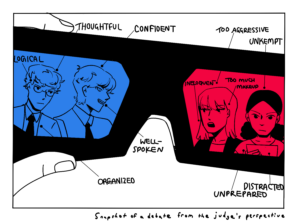Two Voice writers trade takes. This week’s topic: marriage.
Paul:
Marriage is an institution of fear, not of love. Since its inception, the institution of marriage has been deeply interwoven with social, legal, and financial frameworks, and with the world at large, but not without consequences. As Mervyn Cadwallader wrote in 1966, “It spells the end of voluntary affection, of love freely given and joyously received.” His diagnosis remains as prescient as it was over 60 years ago. People justify getting married as a demonstration of commitment, a certificate of true love. But in reality, marriage threatens consensual partnership and fails to reflect modern relationships. It is corrosive and ruinous to its end.
In 2019, the archetypal family unit of two parents and children represented only 20 percent of U.S. households. Beyond that, millions live alone or room with other single people, and 27 percent of children live with a single parent. The idealized nuclear family grossly misrepresents the true living conditions of many in this country, but it is still deeply embedded in arbitrary societal structures. Hospital forms and legal arrangements, for example, tend to reward spouses, along with tax benefits, joint health care plans, and better terms on loans.
Marriage arguably infuses stability into relationships, but that stability is artificial, born of a lack of belief in the natural bonds between two people. Unmarried partners have more freedom to be their own people, independent of the couple as a unit. They operate with dedication to one another for its own sake. A sacred part of the marriage contract is the exchanging of vows expected to last an entire lifetime. In unmarried partnerships, partners renew their dedication every day. When fear exists at the foundation, fear of losing someone or of being alone, marriage twists a relationship until it wears out the original reasons for partnership.
Once trapped in the contract, it becomes more difficult for couples to separate when they no longer want to be together. The legal binding transforms a relationship that requires constant mutual consent into something inert and much more costly to undo.
One of the most compelling reasons against marriage is what happens when it ends. Divorce, while it may prove necessary over the long term, threatens all parties involved, emotionally and financially. As traumatizing as some divorces can be, parents who stay together “for the kids” often create an environment just as stressful, where passive aggression becomes the children’s dominant atmosphere. Furthermore, divorce is a business as much as it is a tool. Matrimonial law garners $28 billion every year. Even when parents do not go after one another for property, legal costs still pose a significant challenge. Children caught in high-conflict divorces often get the worst of it. There is no shortage of parents who blame their children for their marital problems, or pretend the harm they cause is in the child’s interest. Divorce also negatively affects children’s academic performance, mental health, and behavior in their own future relationships.
Breakups happen in any relationship, but in unmarried partnerships, arbitration is left to the couple and not the system; there are far fewer legal hurdles to jump over. A measure of hurt accompanies any major life-shifting event, whether it is a divorce or a breakup, but the disintegration of an unmarried partnership does not pile on the added difficulties of legal fees, children testifying against their parents, and parental one-upmanship that so often accompanies divorces.
Abandoning the arbitrary legal benefits of marriage and the immense social pressure to marry is the only way to end the harm this contract causes. There will always be those who need something to certify themselves and their relationship, but the majority of people should recognize marriage as anachronistic and destructive to relationships, a force against the very thing it purports to safeguard.
Max:
“Do you want to get married?”
I ask this question to nearly every close friend I make. “Not, like, you and me. In general,” I clarify.
The responses vary. Some begin at the showpiece: the wedding. Some friends keep Pinterest boards and binders full of white dresses; others dream up settings: under a garland of flowers. Fewer than thirty people. Definitely not in a church.
Some rave about their ideal partner. Empathetic. Laughs unashamedly. Great abs, or maybe nothing of the sort.
More often than expected, however, I get a shake of the head—derisive, or just ambivalent. I’m not sure—maybe. Or, not over my dead body. I have settled, quietly, in the “if I find the right person” camp, where I occupy a comforting but passive position: a progressing state of perhaps.
These interactions have forced reflection on marriage as a part of social identity. Framed as the highest social institution, marriage dominates the social conversation for most Americans. Married couples also enjoy exclusive systemic advantages and rights—supplemental government benefits, special domestic violence protections, inheritance of property, and a long list of other things. The hyper-idealization of marriage has crept into American entertainment as well: No “happy ending” feels complete without union of the dominant love interests. Marriage is a ubiquitous plot device, found both on-screen and off-screen.
There is some validity to this preoccupation. Studies show marriage, compared to cohabitation or especially single lifestyles, yields higher levels of physical and mental health: Married individuals tend to eat healthier, have stronger immune systems, and have lower chances of becoming depressed. The benefits extend to the pocketbook: Marriage also correlates directly with greater property ownership, incomes, and overall wealth.
Yet we forsake the quality of other relationships by prioritizing marriage so centrally. Because marriage sits atop the hierarchy of social ties, individuals neglect “competing” relationships. UMass-Amherst sociology professor Natalie Gerstel characterizes marriage as “greedy”—it disproportionately dominates time and social currency. Familial and close platonic relationships often suffer post-marriage, with married individuals tending to be less engaged with family members’ lives. Non-romantic relationships are no less important than romantic ones; indeed, they play a critical role in physical, mental, and social health. Marriage also adds a new burden to how other social relationships are conducted: Spouses are suddenly considered mandatory plus-ones, creating a socially burdening effect, as Mandy Catron writes in The Atlantic. Less social flexibility tends to follow, translating to fewer invitations, contacts, and new experiences.
Monogamous marriage also distorts the way we perceive intimacy. Intimacy can and should sometimes be expressed in non-sexual, platonic manners; close, tender contact can be incredibly valuable and restorative to all kinds of relationships. However, fears of infidelity have made intimacy with non-spousal partners less permissible. Platonic intimacy as a whole is considered taboo because monogamy has made intimate contact exclusive to romantic partners.
By no means do I advocate for some radical abolition of marriage. In fact, I see it as deeply important. Yet the privilege and social significance it is awarded must be democratized. The systemic advantages enjoyed by married couples should be extended to any relationship by one’s choice. There’s no reason the only person that can visit you in the ICU should be your spouse. Or that a cohabiting couple or even a number of close friends shouldn’t be able to enjoy “family” insurance rates or visiting rights in incarceration facilities.
Decentralizing marriage will create a more socially connected world—it encourages married couples to equally prioritize and indulge in all important relationships in their lives, not simply each other. Keep the binders and the dreams: Just make space for the rest of the world, too.
Image Credit: Insha Momin and Deborah Han





